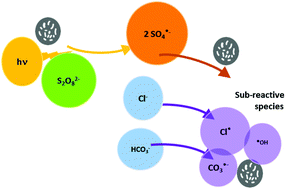Disinfection performance using a UV/persulfate system: effects derived from different aqueous matrices
Abstract
The development of advanced photochemical processes has experienced the emergence of a promising alternative for water disinfection, different from traditional methods. The applicability has primarily been investigated in drinking and wastewater; however, new challenges related to microbiological control in marine waters necessitate evaluating the applicability of this process in such water matrices. In this study, the efficacy of persulfate (PDS) activated with UV-light against E. faecalis has been tested on the bench scale. Firstly, optimization of the different PDS concentrations (1–10 mM) and exposure times (0–5 min) was performed in distilled water. 1 mM of PDS was selected as the best dosage within the range tested. Secondly, in order to evaluate the effects of different inorganic compounds usually found in natural waters, the efficiency of the UV/PDS system was tested in three different matrices: mineral water, saltwater, and marine saltwater. Finally, different bacteria were evaluated in consortium (E. coli + E. faecalis), suggesting the same inactivation level independently on the bacterial groups and structures. The results suggest that PDS is an attractive alternative to other photochemical processes currently in use for seawater treatment and this application deserved further research.

- This article is part of the themed collection: Solar chemistry & photocatalysis: environmental applications – SPEA10


 Please wait while we load your content...
Please wait while we load your content...